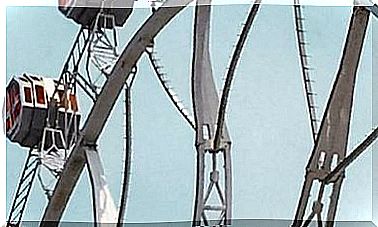Internal Dialogue: Where Does It Come From And What Does It Do?
What is it, where does it come from and what is the role of internal dialogue? Why is it so difficult for us to silence it and prevent us from enjoying the present? We give you keys to understand it, accept it and transcend it.

The conversations we have with ourselves, the internal dialogues, greatly influence our actions and feelings. They are the result of our experiences in childhood, especially at an early age, which will shape our character.
Depending on the relationship we have with our caregivers (parents, grandparents, teachers) we form beliefs about ourselves and about reality. In fact, internal dialogue arises as a defense and protection mechanism against what we experienced in childhood and produced pain. It helped us cope with the injuries and survive to continue growing in an environment from which we could not escape.
Why does the internal dialogue arise?
The internal dialogue a form of adaptation, since at that moment we could not do anything else. We needed those reference figures. It arises from situations in which the child has been neglected in their needs, has been alone, abused, used, little seen or valued, something that can occur because the circumstances of the caregivers did not allow them to be sufficiently present or also because they reproduce what they learned as children.
For example, if a child dies his father, he will feel abandoned and, in addition, his mother may not be present either because of the grief. Or the parents may have to work around the clock to support it. Or that his parents argue constantly and he suffers with it.
In many cases, all these early experiences lead us to develop with some deficiencies that will accompany us in adult life, as the basic needs (to be seen, to feel heard, loved, valued and welcomed, among others) have not been met. childhood.
They are shortcomings before which we started an internal dialogue to justify what was happening.
When we are children we cannot accept the pain that has been inflicted on us, and to manage it we either blame ourselves for what happens or we deny the pain by pretending that we are happy.
In both cases you are not connected with the present experience. As Jorge Bucay says, we put this pain in some barrels that we hide under the water so that no one can see them and we dedicate most of our energy so that they do not rise to the surface and that they remain hidden. This is how we learned to function without parts of ourselves, to survive in a context in which these facets could not be addressed.
Types of internal dialogs
Internal dialogue is the clearest symptom of our neurosis, which takes different forms depending on the character. There are different types of internal dialogue.
- Demanding dialogues. In some people the dialogue is moralistic and demanding, it needs everyone to conform to certain rules of perfection and, when this is not the case, the reaction is angry and accusatory.
- Critical dialogues. In other people, when something happens, the dialogue always turns against them and, instead of criticizing or distributing responsibilities, they blame themselves for everything, they feel that they are worth nothing, that they are a disaster, that they do not deserve respect, they mistreat themselves themselves, they think they are stupid or have an indelible defect, etc.
- Dialogues that blame others. There are people who avoid pain in such a way that in their internal dialogue there is always an external person responsible for their discomfort, because they are very good and wonderful, but others are not able to see it.
- Defensive dialogues. There are also those whose dialogue is basically defensive, because others represent a threat, and thus they attack them while they say they are defending themselves. His dialogue takes the form of “that others do not see me weak, before they hurt me, I do them”.
- Dialogue conciliators. There are also those who have a dialogue in which they always feel that nothing is happening, that it is not with them, and that they seek conciliation all the time without taking themselves into account.
How internal dialogues are reflected in the body
All these types of internal dialogue have their body reflex: a defensive position by sticking out your chest while walking, so as not to show weakness, or lowering your head and shrugging, when you tell yourself that you have no value.
Dialogues create internal emotions that fix the body in a specific position, not allowing adaptability or flexibility. So we have the same reactions over and over again.
This is what we call neurosis, because this internal dialogue takes away our freedom of action, both internally and externally.
How can we break this dynamic?
This dynamic limits us, wears us down, does not allow us to express our spontaneity or develop our potentialities? How could we recover these hidden barrels and not spend so much effort hiding ourselves so as not to enter our original pain?
- To begin with, we should thank these parties for the service they have rendered us in ensuring our survival. For this, a safe environment is necessary that allows us to access the painful content that we hide in these barrels.
- Second, it would be useful to realize that, in the current context, we surely no longer need these parts or the function they served. We are no longer the unprotected children that we were.
- Integrating that pain within us is the necessary condition to eliminate internal dialogue, which we no longer need as protection. It is about bringing together our denied parts and welcoming them with compassion for them and love. Accepting them.
How to reconcile the parts of yourself
Identify the internal dialogue. We are in it when thoughts are intense, repetitive and dead-end. When the mind occupies so much space that we cannot contact reality.
- The acceptation. After realizing that we are in an internal dialogue, we must accept the situation and realize that we are possessed by it, something that is usually characterized by sensations and emotions such as overwhelm, paralysis, fatigue, anxiety, etc. Some known low intensity body pain is also likely to arise. It is convenient to draw attention to him and imagine what he would say if he could speak. Letting it express itself with words or with a movement that comes from the body and not from the mental will liberate it.
- Neither victims nor executioners. When our internal dialogue is based on criticism and judgment, on competition instead of compassion, instead of cooperation and respect, as Thich Nhat Hanh explains, these thoughts harm and de-energize us.
- The power of trauma. The deep wounds that have not been integrated, whether they are from childhood or also from adulthood, trigger the internal dialogue so intensely and unconsciously that the person loses control. In order to integrate these traumatic memories, it is necessary to identify the traumatic situation that we are reliving in order to differentiate it from the current reality. Later, to integrate this situation from the past, it will help us to be able to express the feelings that we could not express at the time of the trauma.
- Focus your attention indoors. It is about being able to focus on what is happening within us and attend to the physical sensations and, if a thought appears, let it pass to refocus the attention on the sensations that we are having in this present moment. Simply by focusing on them, they change.
- Back to the present. When I focus on what I hear, see, smell or taste and I continually name what I perceive with the senses, I place myself totally in the present moment and the internal dialogue disappears.
- To meditate. Meditation is a tool to quiet the internal dialogue by focusing on the breath and quieting the mental noise. With continued practice we can connect with parts of ourselves that are also in us beyond the internal dialogue and connect with our true nature, which is much broader than the identification we have with our mind.









